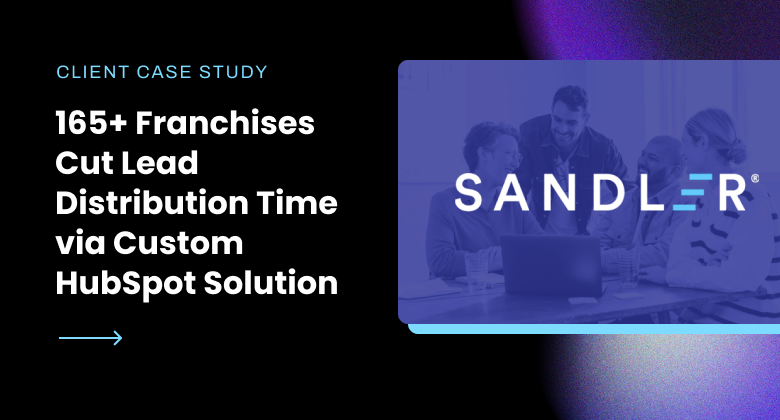HubSpot Strategic Automations & Workflows Strategy Delivery
6 Examples of Custom-Coded Workflow Actions in HubSpot
04/21/2021 • 4 min read • Written by Corie Stark
Table of Contents
Picture this. You’re trying to achieve a specific workflow action within HubSpot. You’ve poked around the standard options, asked for advice from IT, fell down the internet rabbit hole, and still haven’t addressed your unique need.
Do you give up?
You shouldn’t!
Custom-coded workflow actions, available with HubSpot’s Operations Hub Pro, can help. These programmable automation actions are the workflow extension you’ve been searching for, allowing you to do things within HubSpot’s workflow functionality you wouldn’t have been able to before.
Curious? Keep reading for an overview of custom-coded workflow actions and six ways to implement them.
What Is a Custom-Coded Workflow Action and Why Use One?
Custom actions let you define a specific, tailored action that can be executed within a workflow. As suggested, they’re great when you’ve exhausted standard possibilities. Other reasons you may utilize them include:
- If you’re trying to recreate customization or functionality you had in another system
- If you’re onboarding Operations Hub Pro and want to get the most out of it
- If you want to perform all your business processes (marketing, sales, service, accounting, operations) without having to leave HubSpot
Examples of Custom-Coded Workflow Actions
HubSpot's custom coded actions feature enables powerful workflow automation capabilities. At Lynton, we've successfully implemented custom actions for various clients, leveraging this functionality to solve complex business challenges. Here's a quick rundown of some notable projects we've worked on::
1. Deal Renewals
A client came to us to build out a deal renewal workflow with specific components attached. They needed it to trigger promptly after their sales team had closed their initial deal. HubSpot’s traditional workflows for deals let you create a new deal and copy over properties, but our client needed line items also to copy over. To achieve this, we built a custom action to bring over the products and line items properties associated with a deal.
Our custom code action also took leap years into account, as this company sold their software in increments of three or five years. All in all, the custom action allowed our team to code directly within the deal workflow but overcame the limitations of not moving line item properties to a closed-won deal.
2. Job Numbers
Another client approached us needing help including their unique job numbers within their deal workflows. When every deal is created, a specific job number with the current year and a five-digit number is also created. They needed to increment that job number by one digit for every new deal created. Because it was a string of numbers and not a pure numeric field, we needed to build a custom action to account for it.
We also built custom code to search for the newest, existing job numbers to increment them and add them to the right deal. Our code also parses through multiple deals simultaneously to make sure there are no duplicate job numbers. Without custom-coded actions, none of this would be possible because their process was very complex.
While these are the two most significant custom action projects with the most details we worked on, we’ve noticed a few others that may be big once Operations Hub picks up steam:
3. Automatic Links to Deals
Setting up automatic links back to original deals that were auto-generated in custom code is another possibility of this new Operations Hub feature. This would open up a custom property to link to the URL associated with the deal.
4. Automating Tracking Numbers from Outside Systems
The process of tracking accounting numbers from NetSuite (or any other third party system) within HubSpot can be automated via custom workflow actions. This is an example of replicating functionality from one system into HubSpot.
5. Complex Algorithms for Property Calculations
With custom code, more involved property calculations or other calculations not currently available with standard workflow actions are possible. For instance, creating a specific time of calculator based on pages or landing pages on your site and using form fields to capture information.
6. Recommending Associated Products or Resources
Custom code can be used to offer recommendations based on the blog topics, resources, or products a contact views on your website. A custom code action could provide similar ones after they’re done browsing your content.
Quiz Yourself: Is Your Tech Stack Working for You?
Need Help?
With custom-coded workflow actions, HubSpot users like you can extend workflow functionality to empower your business processes. Whether it’s for your operations, sales, or marketing, you’ll be able to move past any workflow roadblocks!
If you’re interested in duplicating any of the examples we provided or would like assistance with your custom action, let us know. We’re here to help.
By: Corie Stark
After spending many years as a sports journalist, Corie switched to marketing in 2013. Her love of writing, talking to people, and keeping up with the industry enables her to use her skills for anything from social media to long-form blogging. Outside of work, she enjoys hiking with her dogs and making her cats chase the ever elusive red dot.
You May Also Like

HubSpot
Lead Distribution 101: Mastering HubSpot's Custom Workflows
Discover how HubSpot custom workflows enhance lead distribution, exploring Sandler Training's transformation from manual rout...
Keep Reading
HubSpot
8 Custom HubSpot Workflows for Talent, HR, and Recruitment Managers
Discover eight powerful HubSpot workflows that transform talent management.
Keep Reading
Web Design
What You Need to Know About Serverless Functions in HubSpot
Explore how HubSpot leverages serverless functions to streamline development workflows, enhance integrations, and boost secur...
Keep ReadingSubscribe Today


